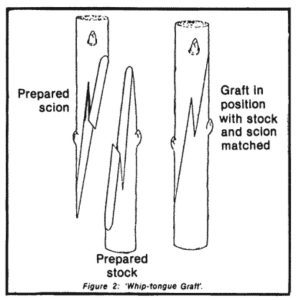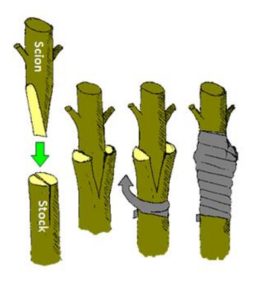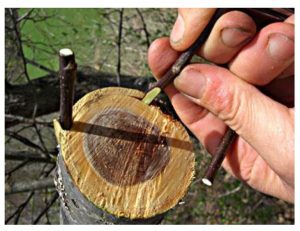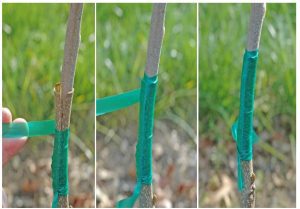Grafting, a fundamental technique in gardening, unites the fates of two plants. This process involves merging the upper part of one plant, known as the scion, with the lower portion of another, called the understock. Essentially, the scion becomes the upper structure of the resulting plant, while the understock transforms into either the root system or part of the trunk.
But why do we graft plants?
Some plant varieties don’t maintain their true characteristics when grown from seeds. Additionally, certain plants prove challenging or even impossible to replicate through cuttings or other propagation methods. Grafting, also known as topworking, offers a solution to these challenges.
It enables the transformation of mature trees into new varieties and allows the use of root systems that are better suited to specific soil types or climates and with the use of specialized understocks or interstems, grafting facilitates the creation of dwarf plants, perfect for compact gardens.
Timing is crucial in the art of grafting.
Most grafting activities take place in late winter or early spring, before the arrival of new growth. Ideally, this should be after the threat of severe cold has passed but well before the onset of hot weather. Scion wood, the plant material for grafting, is typically collected during the winter season. It’s essential to store these scions in a cold, moist environment, maintaining temperatures close to 34 degrees Fahrenheit. At home, you can preserve scions by placing them in a plastic bag within the refrigerator, alongside damp paper towels, or by dipping them in paraffin to retain moisture effectively.
There are three models for tree grafting 
- Saddle or cleft grafting
- Whip or tongue grafting
- Bark grafting
All three models demonstrate how a scion from a desired tree variety can be fitted onto root stock from a tree of the same species to propagate a desired variety. For all three methods, the scion is a twig from the new growth of the desired variety, long enough to have three to five buds on it. The scion is taken (and the entire process is done) in early Spring during budding.
For saddle or cleft grafting and for whip or tongue grafting, the root stock stem size should match the size of the scion. For bark grafting, the root stock is much larger, so that more that one scion can be grafted onto the same root stock, allowing cross fertilization and multiple varieties.
Saddle or Cleft Grafting
Saddle grafting is done by cutting a vertical slit in the root stock and a matching v-shaped point on the scion. As the model shows, the pointed scion can be inserted into the slit, or cleft, in the root stock so that the green cambium layers just inside the bark touch each other as much as possible.
The cambium layer on the scion extends along the outer edges of the v-shaped point and fits along the vertical cambium layer on the two outside edges of the slit or cleft in the root stock. The friction of the v-shaped point holding the cleft open creates stability.
Whip or Tongue Grafting
 In whip or tongue grafting, both the root stock and the scion are sliced on single-slant, matching angles (greater than 45 degrees) so that the entire cambium layer at the outside of each fits together along the slanted surface. Then a vertical slit is cut in each perpendicular to the axis of the slant and closer to the tip of the slant.
In whip or tongue grafting, both the root stock and the scion are sliced on single-slant, matching angles (greater than 45 degrees) so that the entire cambium layer at the outside of each fits together along the slanted surface. Then a vertical slit is cut in each perpendicular to the axis of the slant and closer to the tip of the slant.
When the slanted surfaces are parallel, the upper edge of the slanted surface on the scion, above the slit, fits like a tongue into the slit in the root stock. They can be pushed together so that the cambium layer in each mates up when the slanted surface of the scion rests on the slanted surface of the root stock. The friction created by the tongue fitting in the root stock creates stability.
Bark Grafting
In bark grafting, one or more smaller scions are grafted onto a much larger root stock. Each scion is sliced at one end to create a single-slant point. The bark on the root stock is sliced at the top of the root stock to create a vertical slit in the bark, leaving the cambium layer intact.
Then the scion is inserted into the slit, bark side or tip out. When the scion is angled out slightly from the root stock, the slanted surface of the scion lays flush along the cambium layer of the root stock so that scion’s cambium layer, all the way around the slanted surface, touches the cambium layer of the root stock. The friction between the bark on the scion and the bark on the root stock creates stability.
 Finishing
Finishing
Once the grafts are fitted together, the grafted area is wrapped with rubber band material, electrical tape, or bicycle innertube to seal out air and protect the exposed surface. The moisture in the exposed part of the scion must be conserved by covering the scion with
warm paraffin or a plastic bag.
If electrical tape is used, it must be removed after about three weeks. If the grafts are outdoors, they should be shaded.
Reasons for failure
- Stock and scion were not compatible.
- The cambiums were not meeting properly.
- Scions were upside down.
- Grafting was done at the wrong time.
- Understock or scion were not healthy.
- Scions were dried out or injured by cold.
- Scions were not dormant.
- The graft was not properly covered with grafting wax.
- The scion was displaced by storm, birds or other means.
- The graft was shaded too much by other growth.
- The graft was attacked by insects or disease.
- The graft union was girdled because tape was not cut or released in time.
Grafting opens the door to a world of possibilities in gardening, offering a means to preserve unique plant varieties, adapt to specific environmental conditions, and even craft miniature wonders for your garden space. Master the art of grafting and watch your garden flourish with newfound vitality and diversity.
Source: Master Gardener Presentation and MU Extension Website




 Finishing
Finishing